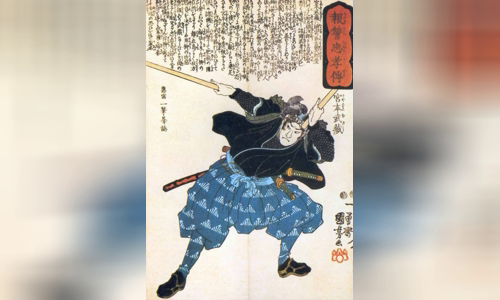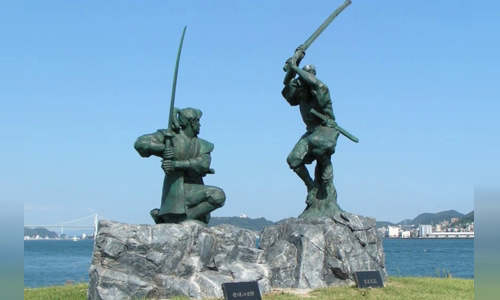In more than 60 sword fighting competitions, Musashi Miyamoto had never lost, even to the top Japanese swords master.
Musashi is said to be born in 1584 in the village of Miyamoto in Harima province, Honshu region, western Japan. Miyamoto Munisai, his father, was also a famous martial artist. Musashi apparently inherited his love for swordsmanship from his father and cultivated his desire to become a great samurai.

Samurai portrait of Musashi Miyamoto follows wood carving by artist Utagawa Kuniyoshi Photo: Wikimedia Commons.
However, the relationship between Musashi and his father is quite complicated. His parents' divorce caused him to often suffer rumors and gossip about his biological mother and also did not get along with his stepmother. After getting older and gaining experience in swordsmanship, Musashi criticized his father's skills, resulting in friction between the two. Musashi often fled to the home of Dorinbo, a Shinto priest, who was later his representative.
The tension between the Miyamoto father and son culminated in a time when Musashi criticized his skills, causing the man to dagger and sword towards him. Musashi dodged both throws and ran away to live with Dorinbo.
Great Japanese Samurai matured during the turbulent times of the country, the war was constantly shaken by the Ashikaga shogunate, then completely collapsed in 1573. By 1600, Japan was divided into two. factions, with the east supporting Tokugawa Ieyasu, who later founded Tokugawa Shogunate, and the west under General Toyotomi Hideyori.
Born in the western region, Musashi served in Hideyori's forces. However, Ieyasu's side won the decisive Battle of Sekigahara on October 21, 1600, helping them consolidate control of Japan. Musashi somehow escaped death, but became a ronin, a derelict samurai.
This situation led Musashi to go on a journey to find new aspirations and become a shugyosha, the word for samurai wandering around to practice their skills by challenging to death with rivals. Musashi disappeared within a few years, supposedly secretly training on Kyushu Island, then re-exporting in 1604.
Fencing is a serious problem in Japan in the past and often people die, even if weapons are just wooden swords like the kind Musashi usually uses. However, death is not really a concern for Musashi as well as other samurai, because they follow the martial spirit, which means putting honor and glory above death.
Musashi participated in the first fighting match at just 13 years old, when he accepted the challenge of an older samurai named Arima Kihei and killed this man. Musashi fought another adept opponent in 1599 and also won. However, notable battles took place after he became a shugyosha, with the first series facing the Yoshioka family, the famed swordsmanship clan in Kyoto.
The first person Musashi challenged and defeated was Seijiro, the eldest son of the Yoshioka family, causing this person to shave his head and become a monk. Denshichiro, Seijiro's younger brother, sought revenge on Musashi in another protest, but was ultimately hit by Musashi's wooden sword, so strong that he died on the spot.
Dozens of Yoshioka family members are said to have sought to kill Musashi with guns or bows and vengeance. However, the experienced samurai protected himself with two swords. This is also a method of fighting to help Musashi become famous, called Niten Ichi-ryu, also known as "the second most beautiful save".
Musashi spent the next few years traveling around Japan and challenging many others to hone his skills and strengthen his reputation. Most of the material about these duels was lost. However, the final match against Sasaki Kojiro, also Musashi's most famous match, is still circulated.
Sasaki Kojiro is a swordsman from the Hosokawa family, the clan that controls the Kokura castle on Kyushu island, famous for tsubame gaeshi, which means "speeding" like a swallow flying and using a long sword about one meter, the meter. Kojiro's reputation reverberated throughout Japan at that time with the nickname "Western Devil". He is said to have never lost in a fight. Musashi was determined to defeat this master swordsman.

The statue recreates the match between Musashi Miyamoto (right) and Sasaki Kojiro on Ganryujima Island, the current name of Funajima Island. Photo: Japan Travel.
Musashi challenged Kojiro through an official at Kokura, who was also his father's former disciple, and was accepted. The battle was decided on the morning of April 13, 1612, on a small, remote island called Funajima, between Honshu and Kyushu.
Musashi arrived late to the challenge site and left Kojiro waiting for three hours, causing Kojiro to lose his temper and rage against his servants. One of them appeased this swordsman by saying that Musashi might not have come because of being too scared of the great Kojiro. However, Kojiro did not accept this explanation because of Musashi's reputation, so being late could only be offensive. In fact, Musashi was sitting on a nearby fishing boat.
"There are many types of agitation. The first is the feeling of danger, the second is the feeling of something beyond your ability, then the feeling of surprise. You should consider them thoroughly." Musashi wrote in the Five Books (Go Rin No Sho), his most famous work. According to some accounts, Musashi took a paddle and leisurely wielded a wooden sword longer than Kojiro's weapon.
Although the appointment time was 8 o'clock, Musashi arrived at around 11:00. In anger, Kojiro rushed forward and threw his scabbard into the sea. "You lost, Kojiro. Only the loser doesn't need his scabbard," Musashi said with a smile.
The insults and being late have brought about the effect Musashi desired. Kojiro immediately swung his sword aimed at the center of Musashi's forehead, but the slash only tore off the bandage tied on his head. Musashi, meanwhile, attacks Kojiro on a similar point with a wooden sword, causing the opponent to fall.
However, Kojiro continued to slash, causing Musashi to injure his thigh, but not hit the artery. Musashi countered by smashing the opponent's left flank, rendering Kojiro unconscious. After checking, Musashi found Kojiro dead and bowed to the officials who witnessed the match and returned to the boat and left, before Kojiro's disciples sought revenge.
By defeating Kojiro, Musashi can claim to be the greatest swordsman in Japan. However, his opponent's death made him feel sad and changed his mind, becoming an introvert. "I understand that I won not because of my superior skill in swordsmanship," he wrote in his work.
"Perhaps I possess some natural talent, or because I have not abandoned some of the natural principles. Are there any other martial styles that are missing something? After that, I decided to find out." more clearly about the profound rules, practicing all night through the night. By the age of 50, I realized that the path of swordsmanship was quite natural, "wrote Musashi.
He became a martial arts master and mastered the philosophy of Zen Buddhism, while pursuing a number of other subjects such as calligraphy and painting. By 1643, Musashi seemed to feel death near and began writing an autobiography. The Five Chapters are completed after two years.
Musashi is thought to have a form of breast cancer. In May 1645, he gave gifts to his disciples and wrote down 21 training principles called Single Action. Musashi died on May 19, 1645.



 Am�lcarTeixeira
Am�lcarTeixeira







